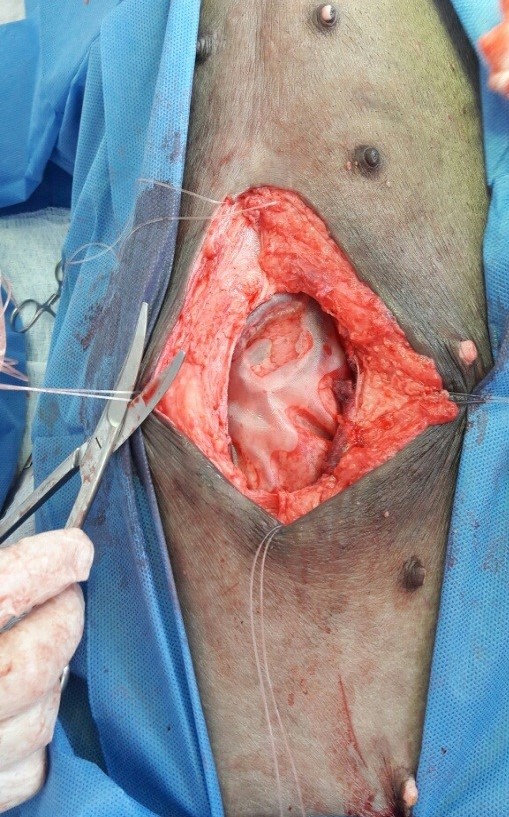Umbilical herniorrhaphy with polyvinyl chloride (PVC) in pigs (sus scrofa domesticus): pilot study
Herniorrafias umbilicales con cloruro de polivinilo (PVC) en cerdos (sus scrofa domesticus): estudio piloto Umbilical herniorrhaphy with polyvinyl chloride

Show authors biography
Objective. To evaluate the clinical effectiveness of PVC on umbilical herniorrhaphy in pigs. Materials and methods. We used 16 clinically healthy pigs of both sexes, aged between 2 and 3 months, Landrace and Landrace x Pietran breeds with an average weight of 20 kg. Inclusion criteria were based on the clinical diagnosis of umbilical hernia. Herniorrhaphy was carried using PVC as a prosthetic material. The implantation of the material was made between parietal peritoneum and abdominal muscles by creating a pocket in 360°, with a depth of five centimeters. For the fixation of the bag, 35 pounds of pressure polyamide was used with “U” points in the fascio-muscular package (four stitches overall), the knots were two centimeters next to the ring, avoiding inverted edges with sustained traction. The size of the PVC bag depended on the size of the ring, but it was constantly rounded and four centimeters larger than the edge of the ring. The parameters evaluated for 15 days were temperature, edema, wound color and dehiscence, and relapse, fistula and appetite for 2 months. Results. An average local temperature of 37.5°C was obtained. Tumor halos of one centimeter at 24 hours post-surgery with involution towards the end of the evaluation. 100% of the animals healed by first intention. 87.5% did not present recurrence of the hernia. 100% did not present signs compatible with fistula or granuloma. Appetite was normal. Conclusions. During the evaluation period, PVC proved to be effective in the correction of umbilical hernias in pigs.
Article visits 1306 | PDF visits
Downloads
- Flecknell P. Anestesia de animales de laboratorio: introducción practica para investigadores y técnicos. 2 Ed. País de publicación; Academic Press Ltd; 1998. https://www.editorialacribia.com/libro/anestesia-de-animales-de-laboratorio-introduccion-practica-para-investigadores-y-tecnicos_53659/
- Reyes I, Pérez E, Pérez F y Reyes L. Malformaciones congénitas en la crianza de cerdos del sector no especializado en el oriente de cuba. Arch Zootec. 2010; 59(228):601-604. http://scielo.isciii.es/pdf/azoo/v59n228/art14.pdf
- Martínez M, Oviedo C, Ballut J. Evaluación clínica de hernioplastia umbilical en bovinos: empleo de fascia abdominal autógena. Rev MVZ Córdoba 2010; 15(2):2111-2117. https://doi.org/10.21897/rmvz.322
- Borraez, O. Abdomen Abierto: Utilización del Polivinilo. Rev Colomb Cir 2008; 23(4):204-209. https://encolombia.com/medicina/revistas-medicas/cirugia/vc-161/cirugia16101-abdomen/
- Ochoa G, Marino C, Riveros S, Morales E, Jarry C, et al. Implementación de un Modelo Porcino de Trasplante Hepático en Chile. Rev Cirugía. 2020; 72(5). https://doi.org/10.35687/s2452-45492020005704
- Acevedo A, Justiniano J, Lombardi J. técnica de Rives-Stoppa en las eventraciones de la línea media: prescindencia de la fijación perimetral de la malla. Rev Chil Cir 2014; 66(2):146-152. http://dx.doi.org/10.4067/S0718-40262014000200009
- Hernández J, Herrera M, Rodero E, Vargas S, Villarreal O, Reséndiz R, Carreón L. y Sierra A. Tendencia en el crecimiento de cabritos criollos en sistemas extensivos. Arch Zootec. 2005; 54:429-436. http://www.redalyc.org/articulo.oa?id=49520748
- Rabelo R, Ferreira F, Paulo N, Flávia A, Franco L, Oliveira M et al. Emprego do compósito látex, poliamida e polilisina a 0.1% na correção cirúrgica de hérnias umbilicais recidivantes em bovinos leiteiros. Acta Sci Vet 2005; 33(2):169-175. https://doi.org/10.22456/1679-9216.14796
- Senet P. Fisiología de la cicatrización cutánea. EM-consulte. 2008. https://www.em-consulte.com/es/article/119845/resume/fisiologia-de-la-cicatrizacion-cutanea
- Lora A, Vega N, Barrios P, Ruiz P. Hernia umbilical: un problema no resuelto. Iatreia 2019; 32(4):288-297. https://doi.org/10.17533/udea.iatreia.28
- Salgado A, Salgado A, Arriba L. Nuevas tendencias en regeneración tisular: fibrina rica en plaquetas y leucocitos. Rev Esp Cir Oral Maxilofac. 2017; 39(2):91-98. http://dx.doi.org/10.1016/j.maxilo.2016.03.001
- Vargas A. Regeneración y cicatrización. Rev Act Clin Med. 2014; (43):2256-2260. http://www.revistasbolivianas.org.bo/pdf/raci/v43/v43_a03.pdf
- Guarín C, Quiroga P, Landínez N. Wound healing process of skin, endogenous fields related and chronic wounds. Rev Fac Med. 2013; 61(4):441-448. https://revistas.unal.edu.co/index.php/revfacmed/article/view/42815/47623
- Acevedo A, Justiniano J, Lombardi J. técnica de Rives-Stoppa en las eventraciones de la línea media. Prescindencia de la fijación perimetral de la malla. Rev Chil Cir 2014; 66(2):146-152. http://dx.doi.org/10.4067/S0718-40262014000200009
- López S, Pérez A, Martínez M. Técnica de Mastoby para preparar ovinos receladores. Rev Med Vet 2018; (36):15-26. http://dx.doi.org/10.19052/mv.5168
- Benítez A, Gómez A, Hernández J, Navarrete R, Moreno L. Evaluation of the productive and economic performance of feed for fattening pigs. Rev Abanico Veterinario 2015; 5(3):36-41. https://abanicoacademico.mx/revistasabanico/index.php/abanico-veterinario/article/view/80.























